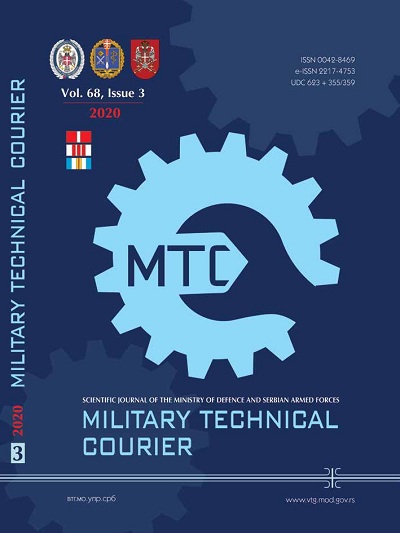Development of a method for determining the size of clearance in sliding bearings
Abstract
Introduction/purpose: The purpose of this paper is to present the importance of applying a new diagnostic method with a monitoring system and its capability to reliably determine when and where the problem will occur related to the wear of plain bearings in further operation of the plant, to offer a quality assessment of how the system will continue to function over time, to predict causes of failures and how to eliminate them as well as to provide time for planned maintenance of technical systems.
Method:The new method solves the problem of sliding bearing diagnostics by measuring the dynamic trajectories (orbit) of the sleeve in the sliding bearing. Modern methods of technical diagnostics based on the measurement of dynamic parameters and electrical quantities and their analysis enable the support of measuring systems and measurement sensors from different manufacturers.
Results: Measurements of the dynamic trajectories of sleeves in sliding bearings determine the values characterizing: normal condition, initial clearance size, further clearance increase, bearing clearance sizes, the moment when the state parameters are close to the upper limit of the allowable clearance, and the specific clearance size when further plant exploitation can cause system failure.
Conclusion: The new diagnostic method and monitoring systems can be widely applied in all technical fields: internal combustion engines, hydroelectric power plants, thermal power plants, process plants, and in many other areas. Many monitoring systems, compatibility of devices and equipment of different manufacturers are supported by hardware and software. The calculations of theoretical and experimental dynamic parameters were verified. The method has a wide range of possibilities of application.
References
Braut, S., Žigulić, R., & Butković, M. 2008. Numerical and experimantal analysis of a shaft bow influence on a rotor to stator contact dynamics. Strojniški vestnik-Journal of Mechanical Engineering, 54(10), pp.693-706 [online]. Available at: https://www.sv-jme.eu/article/numerical-and-experimantal-analysis-of-a-shaft-bow-influence-on-a-rotor-to-stator-contact-dynamics/ [Accessed: 7 April 2020].
Černej, A., & et al. 1986. Radni uslovi podmazivanja ležaja dizel motora. Goriva i maziva, 26(5-6), pp.229-236 (in Serbian).
-Easy-Laser. 2020. Laser measurement & alignment systems. Technical documentation. Damalini, Sweden: Easy-Laser.
Lang, O.R, & Steinhilper, W. 1978. Gleitlager. Berlin, Heidelberg: Springer-Verlag. Available at: https://doi.org/10.1007/978-3-642-81225-5.
Ličen, H., & Zuber, N. 2003. Vibrodiagnostics as an element for quality and reliabilty assurance: SPIDER 8 – universal measuring device, concept and application. In: Quality 2003: 3rd Research/expert conference with international participation, Zenica, Bosnia and Herzegovina, pp.299-306. November 13-14 [online]. Available at: http://www.quality.unze.ba/zbornici/QUALITY%202003/045-R-037.pdf (in Serbian) [Accessed: 7 April 2020].
Žegarac, N. 1989. Dijagnostika kliznih ležajeva u dizel motoru (in Serbian). Ph.D. thesis. Zagreb: University of Zagreb, Faculty of Mechanical Engineering and Naval Architecture.
Žegarac, N. 1993. Postupak dijagnostike ležajeva merenjem dinamičkih putanja glavnih rukavaca, kolenastog vratila. Serbian Patent number P-640/93.
Žegarac, N. 1994. Analysis of the wear of vital parts of turbocharged engines of high specific power. Scientific Technical Review, 44(6), pp.14-24.
Žegarac, N. 2016. Experience in the development of the invention from the aspect of scientific verification and market creation. Vojnotehnički glasnik/Military Technical Courier, 64(1), pp.92-109 Available at: https://doi.org/10.5937/vojtehg64-9315 (in Serbian).
Žegarac, N. 2019. The Application of Modern Diagnostic Systems on Machine and Electric Power Plants. Tehnika, 74(1), pp.73-87. Available at: https://doi.org/10.5937/tehnika1901073Z.
Proposed Creative Commons Copyright Notices
Proposed Policy for Military Technical Courier (Journals That Offer Open Access)
Authors who publish with this journal agree to the following terms:
Authors retain copyright and grant the journal right of first publication with the work simultaneously licensed under a Creative Commons Attribution License that allows others to share the work with an acknowledgement of the work's authorship and initial publication in this journal.
- Authors are able to enter into separate, additional contractual arrangements for the non-exclusive distribution of the journal's published version of the work (e.g., post it to an institutional repository or publish it in a book), with an acknowledgement of its initial publication in this journal.
- Authors are permitted and encouraged to post their work online (e.g., in institutional repositories or on their website) prior to and during the submission process, as it can lead to productive exchanges, as well as earlier and greater citation of published work (See The Effect of Open Access).

